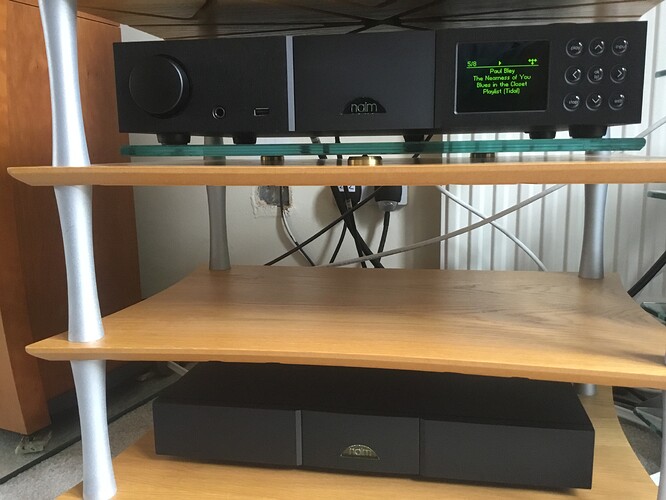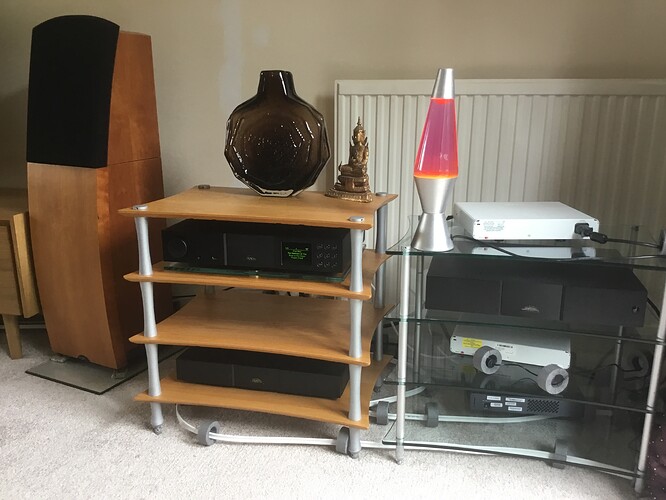Corian data sheet…if not too off topic. 
A hifi friend and I discussed corian for shelves. He felt the Corian was superior to glass. I haven’t tried it. However I have worked with it. It cuts nicely with wood working tools.
I have used brass in turntable vibration abatement, it works well.
Liking the use of cap head bolt heads there, neat bit of repurposing.
Is it possible to give a star ? Consider a star awarded!
I don’t know if it is superior in terms of resonance control, others can comment on that. But yes definitely better to work with than glass and the colour/texture pattern could look very good compared to glass.
Glass can also come in different colours or simply sandblasted though.
I guess if you are going to use another company to manufacture the shelves, workability will not come into it, except then for labour costs.
Well, a penny dropped last night.
The self-created problem I just got rid of started 10 days ago (see post 221 for photo) when I installed 3 silicon nitride balls under a sheet of 10mm toughened glass under my 272 in my oak-shelved Quadraspire rack.
I was aware that one of the 3 steel nuts I used from my box full of random hardware bits was smaller in width and length than the other 2, but it seemed to be the same thickness by eye and when I ran my finger across the 3 of them. I don’t have a micrometer, so cannot check it.
And it didn’t matter that much anyway as it was never anything but a temporary arrangement and a test en route to proper shelf isolation.
It made an improvement in SQ, but also there were a couple of quite nasty rattles when playing loud - but these rattles happened at first then disappeared. But although the SQ was clearer, there was also something bugging me about the hifi since then.
A week ago I order 5 brass nuts from t’Bay for £2 to compare them to the steel nuts.
They arrived and I swapped them in last night.
Bang! A major improvement in SQ. All the benefits of the shelf isolation, but the overall sense that something was wrong with the system vanished entirely.
It seems that the stray steel nut was probably a fraction of a mm thinner after all.
And the brass is probably much better as a support for the ball because it’s softer.
I’m looking forward to getting the more sophisticated isolation system working.
I need to make a decision on what to put under my speakers before I can take the 2 glass shelves out from under them.
From a theoretical perspective, the vibration isolation (by reflection, not absorption incidentally) comes from layering materials of different sound velocity (proportional to hardness / density) with very small contact patches. Hence a hard material against a softer material maximises the reflection.
(If you want vibration absorption btw, very little beats Sorbothane.)
Does this apply to all mechanical vibrations/kinetic energy in the system?
Vibrations come from:
- the various parts of the isolated component vibrating one another;
- movement of attached cables;
- vibration of other components on the rack;
- air movement;
- vibrations from the floor into the rack.
So cup, ball and glass plate carry (reflect?) vibrations away from the component more efficiently than a standard rack shelf alone.
But they also reduce vibrations of the rack entering the component too.
It applies to all essentially elastic interfaces (i.e. where the elastic modulus of both components substantially exceeds the loss modulus of either component).
This does not apply to air movement (or pressure - which you forgot about and is usually more significant than the movement!) or to cables where the flexible insulation has significant loss modulus).
The cup, ball and glass don’t actually carry the vibrations away from a component, they actually reflect it back toward the component and reflect external vibration back into the rack; however the individual components are designed to deal with their own vibrations. The important thing is that they greatly reduce the extraneous vibration coming from the environment (including other components in the system with differing vibrational harmonics) traveling through the rack into the more sensitive components. Setting things like power supplies and power amps on the same isolating components reduces the more aggressive vibrations from these heavier components from entering the rack - connecting these to the rack via a unidirectional vibration path conducting vibration away from components into the rack is exactly what you don’t want!
Incidentally the concept of a unidirectional vibration path (i.e. a mechanical diode) is misinformation promulgated by the marketing department of the various manufacturers of the stainless steel cup and ball type of isolators - these marketing people clearly just don’t understand vibration control!
I moved my 555DR onto my second rack.
Not sure whether to move the NAP 150X across too?
But then everything will change when I get them isolated.
Anyway, the whole system sounds lovely at the moment.
I’ve been so happy since I put those brass nuts in to replace the steel ones.
Well hopefully today or tomorrow you’ll be able to compare that arrangement to single point contact with the brass with the glass held on a ‘floating’ bearing.
Yes, so that should sound even better because:
The contact between glass and ball and brass is minimised to just 2 small points.
The contrast between the hardness of the silicon nitride and the softness of the brass is much greater than in most comparable systems.
The ball is free to move - this means it is automatically stabilised by gravity within the dent, plus the weight of the glass and component pressing down on it.
Will the movements of the ball on the brass over time create a dent within the main dent?
Will this smaller dent still help to fix the ball in place even more?
Will the smaller dent tend to have a slightly more flared concave shape than the ball itself?
Also, it will be more stable on the shelf because the brass cup has a much larger and rougher surface than the tiny brass nut I’m using at the moment.
One of the reasons for pressure forming of the dent in the brass cup is to locally work harden the surface of the dent. this way the surface of the dent is preserved even against the pressure produced by a 555PS sitting on 10mm glass; on (unhardened) soft yellow brass, this pressure is sufficient to mark the surface.
The lack of surface marking ensures as small a contact areas as can be achieved and ensures smooth movement of the ball in response to external force.
Xanthe

Thank you, thank you.

Paul Bley Blues in the Closet has never sounded so good.
Jim
And that’s just with one of the 3 shelves in!
The other 2 are still under my speakers.
Something changed under the speakers? Are you satisfied with the glass shelves under them?
The sound is very clear with the glass under them.
I’m still trying to work out how to move forward on that.
The main options are try some thicker glass, more like 40 x 40cm?
Try marble slab?
Difficult to source and try these things, and quite a strain to actually change them over as the speakers are very fussy to set up.
I don’t think it’s sensible to try Gaia type footers or podium as they will probably not work with the leaf spring mechanisms of the SL2s.
Butcher blocks? Aluminum slab? These two are sometimes used under speakers.


I tried granite and marble but don’t like the effect.
As @JimDog likes the effect of the glass, I suspect the way forward for him is the use of rigid materials under the speakers; so I think toughened glass (possibly thicker maybe 18 or 20mm), ceramic tile or possibly aluminium are the most promising ways forward.
I understood that very clear is not so positive effect. Very clear as a bit glassy, bright or very clear as clean and transparent?
Yes, but as the glass gets much thicker it should be less bright.

